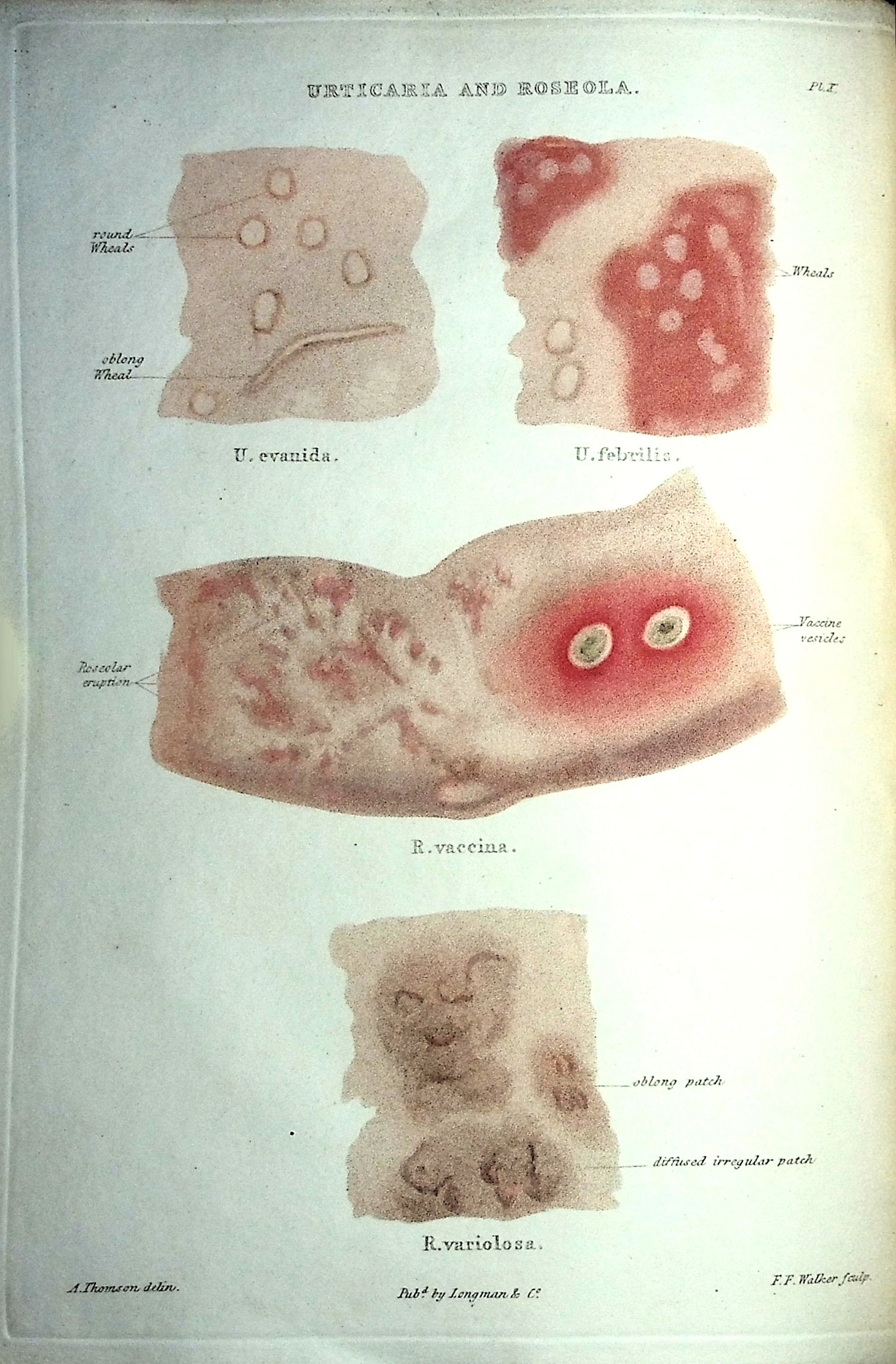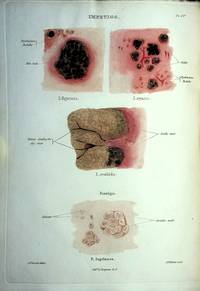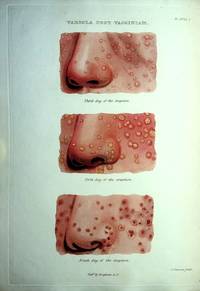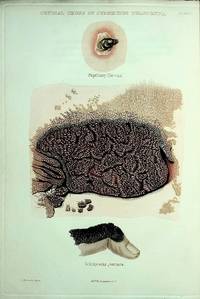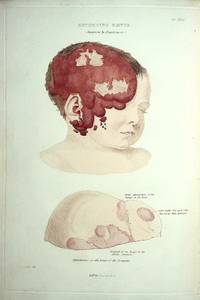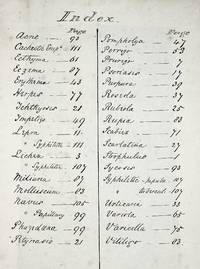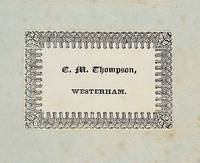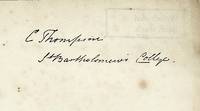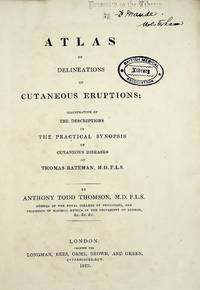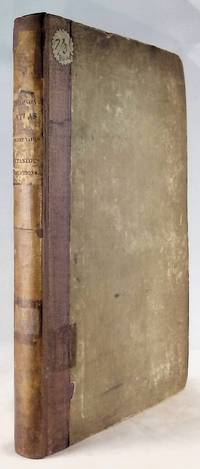Atlas of Delineations of Cutaneous Eruptions Illustrative of the Descriptions in the Practical Synopsis of Cutaneous Diseases of Thomas Bateman
- SIGNED Leather spine, brown paper-covered boards
- London: Longman, Rees, Orme, Brown, and Green, 1829
London: Longman, Rees, Orme, Brown, and Green, 1829. First edition.
1849 BRILLIANT HAND-COLORED ATLAS OF SKIN DISEASE BY SCOTTISH PHYSICIAN.
9 ¾ inches tall hardcover, leather spine with paper title label, brown paper-covered boards. Bookplate of C. M. Thompson, Westerham, to front paste-down, ink inscription, "C Thompson/ St Bartholomew's College" top of front free endpaper. Handstamp, "Withdrawn from stock" verso ffep. Handstamp, Presented to the Library by Maude, Westerham, top of title page. Handstamp, "British Medical Association Library" to title page and preliminary pages. i-vii, 112 pp, 29 hand colored engraved plates each with tissue guard and accompanying descriptive text. The back paste-down contains an autograph index of the diseases. Wear to covers, light foxing to preliminary pages and tissue guards, plates clean and bright. Very good minus in custom archival mylar cover. In the ADVERTISEMENT (PREFACE) the author explains that this atlas is intended as an affordable substitute for Bateman's Delineations of Cutaneous Disease. However, Thomson has made his atlas more useful to the student and physician by showing in each plate the progression of the lesions. He has also added more lesions than provided by Bateman. Moreover, the plates of this atlas have been engraved and colored by the father and son who produced the large Bateman work.
ANTHONY TODD THOMSON (1778 – 1849) was born in Edinburgh, where his parents were staying temporarily, in 1778. His father was postmaster-general of the Province of Georgia, and collector of customs for the town of Savannah. He graduated doctor of medicine at the University of Edinburgh in 1799, and in November of the same year he became a member of the Royal Medical Society. He spent the next twenty five years as a general practitioner in Sloane Street, Chelsea. In 1828 he became the first professor of materia medica and therapeutics at London University (now University College London). In 1832, on the death of John Gordon Smith, he was appointed joint professor of medical jurisprudence with Andrew Amos. In 1837 Amos was appointed a member of the Governor-General's Council of India and so Thomson became sole professor.
THOMAS BATEMAN (1778-1821) was a British physician and a pioneer in the field of dermatology who was a native of Whitby, Yorkshire. He earned his medical degree from the Edinburgh Medical School. Bateman was a student, colleague and successor to Robert Willan (1757–1812) in regards to modern dermatological practices of classification. Prior to the 19th century, classification of skin diseases were based on symptomatic characteristics. Dr. Willan was the first to propose a rational naming standard based on the appearance of the skin disorder. In the treatise On Cutaneous Diseases, Willan was the first to classify skin diseases from an anatomical point of view. However, Willan died in 1812, leaving Bateman to continue and expand on the work of his mentor. In 1813 Bateman published A Practical Synopsis of Cutaneous Diseases According to the Arrangement of Dr Willan, and in 1817 published an atlas called the Delineations of Cutaneous Disease.
PROVENANCE: C. M. THOMPSON (1797 - 1878) earned his medical degree in 1817 from St. Bartholomew's College, London, then settled at Westerham, where he practiced medicine and surgery as a country doctor for nearly 50 years. His obituary in the British Medical Journal (January 26, 1878, p 144) concludes, "He was a skilful surgeon, and an accomplished practitioner; ever ready to accept all new aids in the treatment of disease, and retaining those he found to be true."
1849 BRILLIANT HAND-COLORED ATLAS OF SKIN DISEASE BY SCOTTISH PHYSICIAN.
9 ¾ inches tall hardcover, leather spine with paper title label, brown paper-covered boards. Bookplate of C. M. Thompson, Westerham, to front paste-down, ink inscription, "C Thompson/ St Bartholomew's College" top of front free endpaper. Handstamp, "Withdrawn from stock" verso ffep. Handstamp, Presented to the Library by Maude, Westerham, top of title page. Handstamp, "British Medical Association Library" to title page and preliminary pages. i-vii, 112 pp, 29 hand colored engraved plates each with tissue guard and accompanying descriptive text. The back paste-down contains an autograph index of the diseases. Wear to covers, light foxing to preliminary pages and tissue guards, plates clean and bright. Very good minus in custom archival mylar cover. In the ADVERTISEMENT (PREFACE) the author explains that this atlas is intended as an affordable substitute for Bateman's Delineations of Cutaneous Disease. However, Thomson has made his atlas more useful to the student and physician by showing in each plate the progression of the lesions. He has also added more lesions than provided by Bateman. Moreover, the plates of this atlas have been engraved and colored by the father and son who produced the large Bateman work.
ANTHONY TODD THOMSON (1778 – 1849) was born in Edinburgh, where his parents were staying temporarily, in 1778. His father was postmaster-general of the Province of Georgia, and collector of customs for the town of Savannah. He graduated doctor of medicine at the University of Edinburgh in 1799, and in November of the same year he became a member of the Royal Medical Society. He spent the next twenty five years as a general practitioner in Sloane Street, Chelsea. In 1828 he became the first professor of materia medica and therapeutics at London University (now University College London). In 1832, on the death of John Gordon Smith, he was appointed joint professor of medical jurisprudence with Andrew Amos. In 1837 Amos was appointed a member of the Governor-General's Council of India and so Thomson became sole professor.
THOMAS BATEMAN (1778-1821) was a British physician and a pioneer in the field of dermatology who was a native of Whitby, Yorkshire. He earned his medical degree from the Edinburgh Medical School. Bateman was a student, colleague and successor to Robert Willan (1757–1812) in regards to modern dermatological practices of classification. Prior to the 19th century, classification of skin diseases were based on symptomatic characteristics. Dr. Willan was the first to propose a rational naming standard based on the appearance of the skin disorder. In the treatise On Cutaneous Diseases, Willan was the first to classify skin diseases from an anatomical point of view. However, Willan died in 1812, leaving Bateman to continue and expand on the work of his mentor. In 1813 Bateman published A Practical Synopsis of Cutaneous Diseases According to the Arrangement of Dr Willan, and in 1817 published an atlas called the Delineations of Cutaneous Disease.
PROVENANCE: C. M. THOMPSON (1797 - 1878) earned his medical degree in 1817 from St. Bartholomew's College, London, then settled at Westerham, where he practiced medicine and surgery as a country doctor for nearly 50 years. His obituary in the British Medical Journal (January 26, 1878, p 144) concludes, "He was a skilful surgeon, and an accomplished practitioner; ever ready to accept all new aids in the treatment of disease, and retaining those he found to be true."


